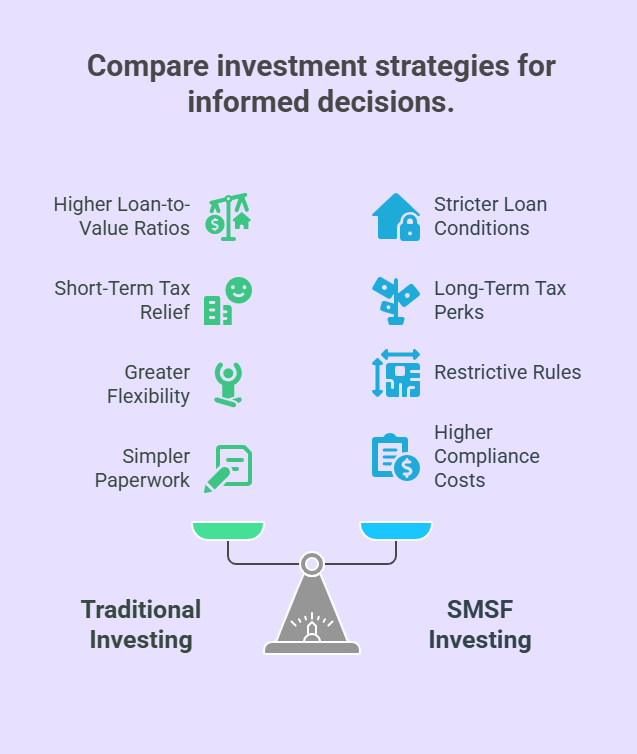One Structure Won’t Fit Every Investor
When it comes to growing wealth through property, strategy matters—but so does structure. For many investors, the big question isn’t whether to invest, but how. Should you buy in your own name? Or should you use your self-managed super fund (SMSF) to purchase property for your retirement?
The right structure can unlock tax efficiencies, long-term growth, and retirement security. The wrong one can create red tape, limit flexibility, or stall your momentum altogether.
This guide breaks down the key differences between SMSF property investing and traditional property investing, and helps you decide what aligns with your goals, risk tolerance, and financial stage.
What Is SMSF Property Investment?
Self-Managed Super Fund (SMSF) is a private superannuation fund that you manage yourself, typically with up to 4 members (soon to be 6). Instead of relying on industry or retail super funds to manage your money, you’re in control—and that includes the ability to invest in residential or commercial property.
But there’s a catch:
• You can’t live in the property or rent it to family or friends
• You must buy at arm’s length, meaning it has to be a true investment
• All decisions must serve the sole purpose of providing retirement benefits
For investors with significant super balances, this can be a powerful way to diversify away from shares and manage retirement assets directly.
What Is Traditional Property Investment?
This is the model most investors start with: buying in your personal name, via a trust, or under a company structure. It offers greater flexibility, access to lending, and the ability to live in or rent out your property as you see fit.
Traditional investment lets you:
• Leverage your income and equity
• Maximise tax offsets (e.g. negative gearing)
• Buy, renovate, or sell with minimal restrictions
It’s generally more hands-on—but far less regulated than SMSF investing.
SMSF vs Traditional: A Side-by-Side Comparison
➤ Lending Power
Traditional loans typically allow for higher loan-to-value ratios (LVRs), lower interest rates, and broader lender options.
SMSF loans are limited to
70–80% LVR, come with stricter conditions, and require a
bare trust structure. Many banks have pulled back from SMSF lending altogether.
Verdict: If maximising leverage matters, traditional investing wins.
➤ Costs & Complexity
Setting up and running an SMSF involves:
- Annual audits
- ATO compliance
- Ongoing admin and legal costs
Traditional investing is far simpler in terms of paperwork and regulation.
Verdict: SMSFs require a much higher level of compliance and professional support.

➤ Control & Flexibility
Traditional investors have the freedom to renovate and add value to their properties as they choose. They can also access the equity within their investments to grow their property portfolio.
Additionally, they have the flexibility to sell, refinance, or restructure their assets without facing significant regulatory hurdles or red tape. With SMSFs, borrowing rules are strict. You can’t improve a property with borrowed funds, and there are complex rules around refinancing or subdividing.
Verdict: SMSF investing is restrictive; traditional investing is far more agile.
➤ Tax Benefits
SMSF property income is taxed at 15%, and capital gains are taxed at just 10% after 12 months. Once the fund enters pension phase, tax can drop to 0%.
Traditional property offers negative gearing, depreciation, and the ability to offset losses against your taxable income—especially valuable if you earn a high salary.
Verdict: SMSF offers long-term retirement tax perks; traditional gives short-term cash flow relief.
When SMSF Investing Makes Sense
SMSF property investment may be a good fit if:
- You have a super balance of $200K or more (combined if with a partner)
- Your borrowing capacity outside super is limited
- You’re playing a long game focused on retirement
- You want to diversify your super away from market volatility
- You have access to a strong, experienced advisory team
When Traditional Investing Is a Better Fit
Traditional investing may suit you better if:
- You’re earlier in your career and want to build a high-growth portfolio
- You need flexibility to renovate, flip, or access equity
- You want negative gearing benefits to offset your PAYG income
- You’re looking to create income and freedom before retirement age
Can You Do Both? Absolutely.
The most strategic investors often use both personal and SMSF property structures at different stages of their journey. For example, you might start investing in your personal name while building up your superannuation. Once your SMSF reaches a strong balance, you could use it to purchase a second or third property—potentially even securing a commercial asset for your business or retirement income.
It’s not an either/or decision—it’s about smart sequencing.
Ask Yourself These Questions Before Deciding:
- What’s your primary goal—growth now or retirement security later?
- What’s your current super balance and borrowing power?
- Do you need tax offsets now, or are you thinking long-term?
- Are you ready to manage the complexity and compliance of an SMSF?
The answer isn’t just in the numbers—it’s in how your strategy aligns with your stage of life.
Final Thoughts: Strategy First, Structure Second
Don’t pick a property structure based on hearsay or tax minimisation alone. The best investors build a
long-term strategy, then choose the structure that supports it.
Whether you’re weighing up SMSF vs traditional—or wondering how to combine both—the real key is clarity.
And that’s where Living Property comes in. Let’s talk through your goals, numbers, and options.
Book your Discovery Call session with us today.
Start With An Obligation Free Consltation
Our Obligation Free Consultations are designed for you to ask us anything you like and start the process of uncovering a strategy suited to your circumstances.

